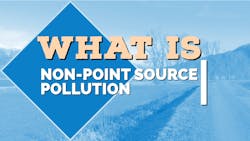Non-point source pollution is pollution that originates from several sources such as from land run-off, precipitation, and seepage that mix together as the runoff moves. This pollution is termed non-point because it contains a mixture of pollution originating from several sources including fertilizers and chemical use on agricultural land.
The two categories of non-point source pollution
The Indiana Department of Environmental Management classified non-point source pollution into two major categories based on land use: agriculture and urban.
Land for crop production and livestock are examples of agricultural land while wetlands and developed areas not used for agriculture are examples of urban land.
Major types of non-point source pollution
Some of the major types of non-point source pollution, as identified by the Indiana department of Environmental Management, are:
1. Microorganisms such as E.coli (Escherichia coli)
While this is an indicator of animal or human waste polluted water, it is also an indicator of combined sewer overflows that occur due to stormwater runoff containing untreated sewage. Pollution with this bacterium can cause illnesses.
2. Nitrogen and phosphorus
Agricultural fertilizers are the primary source of nitrogen and phosphorus run-off. Excessive amounts of nitrogen and phosphorus in stagnant water bodies lead to algal growth and dead, decaying algae depletes the water’s oxygen supply in turn leading to the death of aquatic organisms.
3. Sediment
Farm fields employing conventional tilling and lacking a continuous layer of vegetation, over-grazing by livestock creating pasture erosion, and improperly managed construction sites are some of the causes of sediment run-off. Featuring loose sand, clay, or silt, sediment is a common pollutant in water bodies because it damages aquatic life, contributes to erosion, and decreases the recreational value of the water body, according to U.S. EPA.
Differences between non-point source pollution and point source pollution
Non-point source pollution differs from point source pollution based on the sources, ease of management, and regulation as summarized in Table 1 (See below). Because non-point source pollution originates from multiple sources that could mix together such as from urban and suburban run-off, it is difficult to manage because the effects of the run-offs are cumulative. Additionally compares to point source pollution for which facilities must have a permit to discharge, there is no such clear-cut regulation for non-point source pollution management. Section 319 of the Clean Water Act provides funding to support projects concerning nonpoint pollution.
Preventing non-point source pollution
U.S. EPA, on its website for nonpoint source pollution, mentions several strategies for how to prevent non-point source pollution originating from urban environment, forestry, and agriculture.
Some of the preventive measures include disposing used oil, antifreeze, paints and other chemicals to community facilities for hazardous wastewater disposal rather than disposing them in drains or storm sewers. Preventive measures also include the use of proper erosion control practices to minimize runoffs containing pollution.
Regulations and comlpliance for non-point source pollution
Under the Clean Water Act, Section 319, states, territories, and delegated tribes, if they wish to receive CWA Section 319 funds, are required to submit their non-point source pollution management plans to EPA. Once EPA approves the plans, the applicants (states, territories, delegated tribes) become eligible for Section 319’s grant program.
The key components of a state nonpoint source pollution management program includes the Best Management Practices to restore the impaired water body and partnership with other key state and local nonpoint source entities to implement control measures. In 2022, according to data on EPA's website, the Section 319 grant total awarded was $178 million, compared to $155.9 million in 2013.
The receiving parties (states, territories, and tribes) must comply with the approved non-point source pollution management plans. They also need to complete and update their non-point source management plans every five years.
Challenges associated with meeting project objectives under the 319 fund program
A study published by the US Government Accountability Office in 2012 mentioned that many projects funded by Clean Water Act Section 319 funds faced considerable challenges in project implementation such as low levels of participation.
Other challenges include the impact of the new redefinition of the “Waters of the US” which removes protection for millions of miles for streams and acres of wetland. This new definition makes it difficult to effectively implement non-point source pollution management plans because pollution from the Waters of the U.S. can diffuse into nearby water bodies making it impractical to maintain them under the funding program.
Climate change is another factor – it could increase water pollution by increasing runoffs into water bodies due to increasing events of heavy rainfall. When powerful storms drop large volumes of water in a short period of time, there is more combined sewer overflow. Thus, there is a need to address these concerns when submitting non-point source management plans for the Section 319 funds to be effective to maintain the water quality.
Variability in enforcement mechanisms in regard to agricultural pollution (sediments and fertilizers) and land use regulations, which could vary between states, also makes in challenging to effectively use the Section 319 funds to enforcement nonpoint source pollution plans.
Non-point source pollution summary
Non-point source pollution is one of the most significant sources of pollution in impaired water bodies. Runoff from farming and livestock pasturing are the common sources of non-point source pollution.
While the regulations of non-point source pollution are not addressed like point source pollution in the Clean Water Act, the Clean Water Act includes Section 319 which is a grant program to provide funds to states, tribes, and territories to develop and implement non-point source pollution programs.
However, there are challenges associated with the use of the funds under Section 319, as discussed above, that must be overcome to fix impaired water bodies affected by nonpoint source pollution.
About the Author
Saleha Kuzniewski
Saleha Kuzniewski, Ph.D. has authored several publications in the fields of scientific research, biotechnology, and environmental regulations. She is the winner of the 2023 Apex award for publication excellence. She is also the founder of Environmental Remediation & Innovations, LLC. Kuzniewski can be reached at [email protected].

